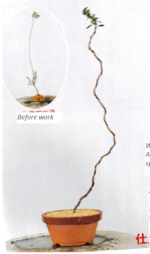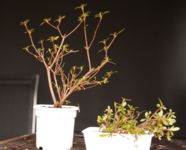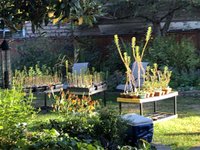The basic Japanese way to train satsuki is through whips:

They are not trained to be straight. The nursery grows them as tall as possible. Then the customer can wire them upon buying. The grower does the hard work to try to grow them as fast and tall as possible. And the customer can immediately design on a trunk shape. After that, because of basal dominance, the customer no longer has to worry about the lack of apical dominance, because the entire bare bones of the final design is already there.
If you are interested in flower display satsuki, you are generally also interested in the newest varieties. And these plants are of course going to be very young.
So you get to buy 2 year old plants, and most specialist growers sell these as 'whips'.
If the nursery grower doesn't prioritize growing it very tall as fast as possible, you get multitrunked plants like Leatherback has, where it will be almost impossible to put movement in the bottom part when the top part hasn't evne grown yet, relative to these whips. (though Leatherback's plants seem to have been selectively pruned at least a little bit).
Here is actually an example where the instructor used wire to demonstrate the ideal position of future branches using wire:

As you can see, most of the time you want the branches to slope downward. A broom style would be very different, and is also possible.
I have more pictures and examples of many styles and all common varieties, all from Japanese sources.
Note that most of these become flower display satsuki.
Note that an untrained satsuki, even when pruned to be single trunked, is never completely straight. Once a new shoot starts to grow in spring, it will always come out at an angle relative to the current trunk.
So if you actually want to go for a formal upright chokkan bonsai, you actually have a bit of a challenge.
To make clear my point on wiring and getting back to Leatherback's plants, it will not be so easy to get a meaningful bend in the first section of these.
You will have to work with the bend that is already there for the transition to the new growing season. In the Japanese whip example, these sections can be 40cm long. In Leatherback's plants, maybe it is 10cm?
Therefore, I do think you would want to wire when spring comes. And try to work with the bends created at the grow nodes, and make them more extreme. And then maybe add an actual flowing bend in the straight sections of the newest growth.
Because the flowers are large, getting it to be fall is the number 1 goal, I would say.
@
AnutterBonsai picture shows how the Japanese would train a Asuka. And at that point you basically want to strengthen the foliage pads, make them tighter, more refined and without gaps. And just display the flowers.
Of course, you'd also work to improve the nebari every repot. And after enough years, you may want to redesign. And if you really want to get a fat trunk, you need to field grow them for several decades.
With young plants, I think the easiest way to get a stylized bonsai with character is to go 2 or 3 trunks. Then, the trunks can be very thing, but the overall plant can have a lot of character.
If you are really skilled and dedicated at wiring, you can make it very impressive fast. Field-growing an azalea for 30+ years to get a fat trunk isn't really possible. Especially not since the growth rate of satsuki seems to be about half of what it is is in Japan if you live in the Netherlands or Germany.









